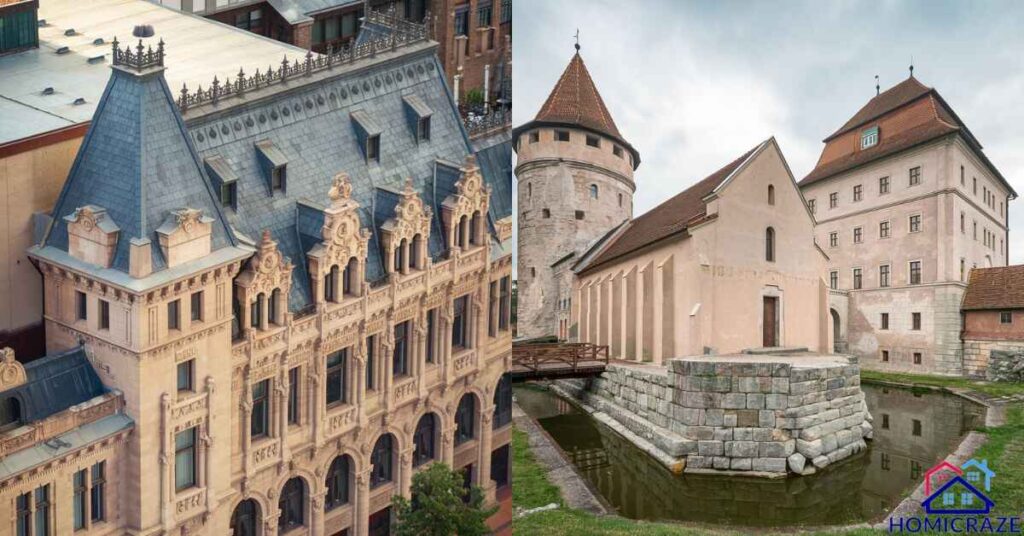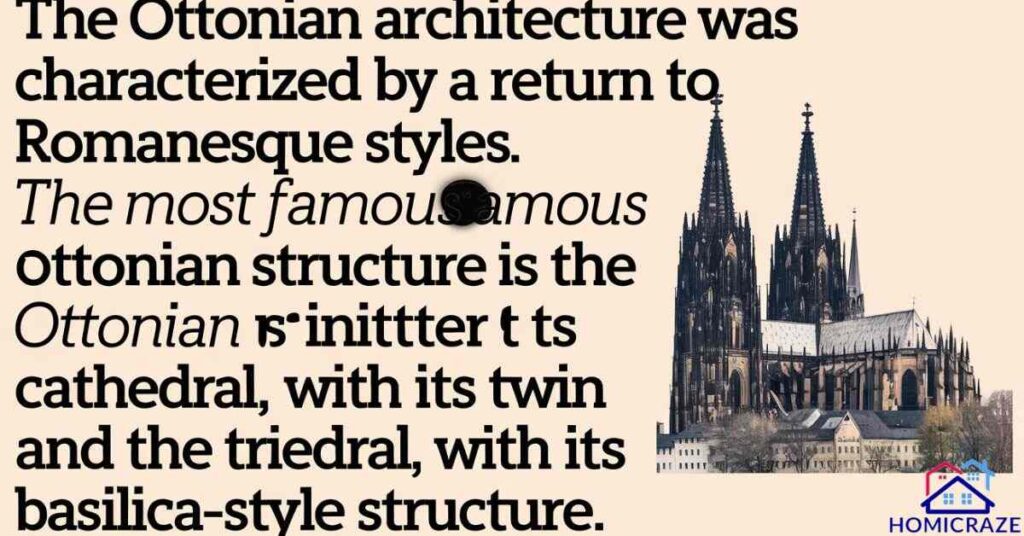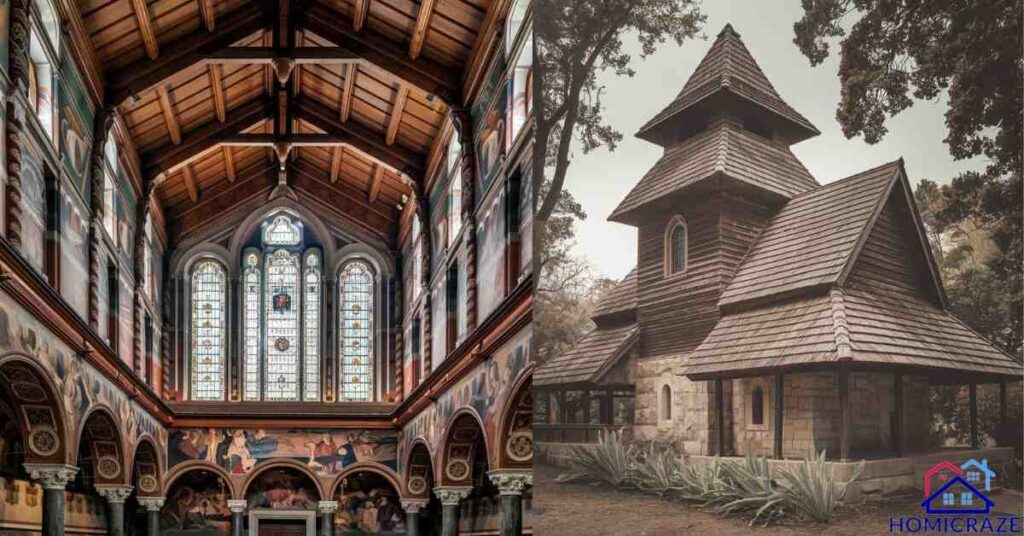Identifying Ottonian architecture can be challenging for many history and art enthusiasts. This unique style, developed during the Holy Roman Empire’s early years, often gets overlooked or confused with other medieval forms.
The lack of clear distinctions can lead to misunderstandings about this crucial period in architectural history. Ottonian architecture represents a significant bridge between Carolingian and Romanesque styles, influencing European building design for centuries.
This comprehensive guide will demystify Ottonian architecture, providing clear examples and key characteristics. By the end, you’ll confidently recognize Ottonian structures and understand their importance in the evolution of medieval architecture.
The Origins of Ottonian Architecture
The Ottonian dynasty ruled from 919 to 1024 CE. They shaped German architecture in the 10th century. This period saw a revival of Roman styles. The Ottonians built many churches and monasteries. Their architectural style blended old Roman and new German elements. This fusion created a unique look that later influenced Romanesque architecture.
Key Characteristics of Ottonian Architecture
Ottonian buildings have distinct features. Thick walls and small windows are common. They often have two opposing apses. Westworks, or elaborate western façades, are typical. The interiors have alternating support systems. This means columns and piers alternate. Crypts are larger and more complex. Ottonian churches usually have tall, narrow towers. These elements set Ottonian architecture apart from earlier styles.
Identifying Examples of Ottonian Architecture
Ottonian buildings share certain traits. Look for massive stone structures. They often have a cruciform plan. The exteriors are plain with little decoration. Inside, you’ll find large open spaces. Rounded arches are common. The overall design is symmetrical and balanced. These features help identify Ottonian architecture among other medieval styles.
St. Michael’s Church, Hildesheim: A Prime Example
St. Michael’s Church in Hildesheim is a perfect Ottonian example. Built in the early 11th century, it shows key Ottonian features. The church has a symmetrical plan with two apses. Its alternating support system is clear inside. The westwork is impressive. UNESCO recognized its importance by naming it a World Heritage Site. St. Michael’s remains one of the best-preserved Ottonian churches.
Other Notable Ottonian Structures

Several other buildings showcase Ottonian style. The Abbey Church of Gernrode is one example. It dates from the 10th century. The Mainz Cathedral is another important Ottonian structure. Parts of Speyer Cathedral also show Ottonian influence. These buildings helped shape later Romanesque architecture. They provide valuable insights into Ottonian design principles.
The Influence of Faith on Ottonian Architecture
Christian faith deeply influenced Ottonian architecture. Churches were designed to inspire awe. They represented heaven on earth. Symbolic elements were important. The layout often mirrored religious ideas. Light was used to create a spiritual atmosphere. These design choices reflected the strong religious beliefs of the time. Ottonian churches were more than buildings; they were expressions of faith.
An Artist of Faith: Patrice Brown’s Perspective on Sacred Architecture
Patrice Brown, a modern artist, sees links between faith and architecture. She believes sacred spaces should evoke spiritual feelings. Brown studies how Ottonian builders used design to express faith. She applies these ideas in her own work. For Brown, architecture can be a form of prayer. Her perspective shows how Ottonian principles still inspire today’s artists and architects.
Ottonian Architecture vs. Other Medieval Styles
Ottonian architecture has unique features compared to other medieval styles. It blends elements from Carolingian and Byzantine traditions. Ottonian buildings are more massive than Carolingian ones. They have less decoration than Byzantine structures. Early Romanesque churches share some similarities with Ottonian designs. Here’s a simple comparison:
| Feature | Ottonian | Carolingian | Byzantine | Early Romanesque |
| Size | Large | Smaller | Varies | Large |
| Decoration | Minimal | Moderate | Elaborate | Minimal to moderate |
| Arches | Round | Round | Round | Round |
| Towers | Multiple | Single | Domed | Multiple |
Which Of The Following Is An Example Of Ottonian Architecture
Identifying Ottonian architecture can be tricky. St. Michael’s Church in Hildesheim is a classic example. It has thick walls and a symmetrical plan. The Abbey of Corvey is another Ottonian building. It features a westwork, typical of this style. Ottonian churches often have alternating pillars and columns. They usually have two choirs, one at each end. These features set them apart from other medieval styles.
The Legacy of Ottonian Architecture
Ottonian architecture left a lasting mark on later styles. It heavily influenced Romanesque architecture. The use of massive walls continued in later churches. Ottonian westworks inspired similar structures in Romanesque buildings. The alternating support system became common in medieval architecture. Ottonian ideas about light and space shaped later church designs. This style bridged the gap between early medieval and Romanesque architecture.
Design With Purpose: Lessons from Ottonian Architecture
Ottonian architects designed with clear purposes in mind. They created spaces to inspire awe and devotion. Every element had a symbolic meaning. The layout of churches reflected religious ideas. These principles still apply in modern design. Today’s architects can learn from Ottonian focus on purpose and symbolism. Good design always serves a clear function, just as Ottonian buildings did.
Read This Blog: Rub and Buff Colors: Popular Options for Antique Restoration
Ottonian Architecture in Literature

Writers often use Ottonian architecture in their stories. It adds a sense of history and grandeur. Historical novels set in medieval times might describe Ottonian churches. These buildings create a backdrop for dramatic scenes. Some authors use Ottonian structures as symbols of power or faith. In fantasy literature, writers might draw inspiration from Ottonian designs for imaginary castles or temples.
The Barber Flannery O’Connor: Architectural Symbolism in Literature
Flannery O’Connor’s story “The Barber” doesn’t directly mention Ottonian architecture. However, it uses building imagery to convey ideas. The barber shop represents a place of conflict and change. This mirrors how Ottonian churches were centers of community life. O’Connor’s use of architectural symbols shows how buildings can represent larger concepts in literature.
Preserving Ottonian Architectural Heritage
Preserving Ottonian buildings is important work. Experts use special techniques to protect these old structures. They carefully clean and repair stonework. Sometimes, they replace damaged parts with matching materials. Preservationists also control the environment inside these buildings. This helps prevent decay. Many countries consider Ottonian structures national treasures and protect them by law.
Challenges in Maintaining Ottonian Buildings
Keeping Ottonian buildings in good shape is hard work. These structures are very old and fragile. Weather and pollution cause damage over time. Sometimes, earlier restorations used harmful materials. Finding skilled craftspeople who understand ancient techniques is difficult. Balancing preservation with modern safety standards can be tricky. Funding for maintenance is often limited.
Modern Interpretations of Ottonian Architecture
Some modern architects find inspiration in Ottonian style. They might use thick walls and small windows like Ottonian builders did. New churches sometimes have symmetrical plans similar to Ottonian designs. Architects may create modern versions of westworks. They often try to capture the spiritual feeling of Ottonian spaces in new buildings.
Also Read This Blog: Average American Bedroom Size Guide
Case Study: A 21st Century Church Inspired by Ottonian Principles
A recent church built in Germany shows Ottonian influence. It has thick stone walls and small, high windows. The layout is symmetrical, like many Ottonian churches. Inside, the columns alternate in style. This mirrors the Ottonian alternating support system. The architects used modern materials but kept the Ottonian spirit. This church shows how ancient ideas can inspire new designs.
The Role of Ottonian Architecture in Art History
Ottonian architecture holds a special place in art history. It marks a transition between early medieval and Romanesque styles. Ottonian builders developed new techniques that influenced later architects. Their churches show a blend of Roman, Byzantine, and German ideas. Art historians study Ottonian buildings to understand medieval culture and technology.
Ottonian Architecture in Medieval Manuscripts and Artworks
Medieval artists often drew Ottonian buildings in their works. Illuminated manuscripts show detailed pictures of Ottonian churches. These images help us understand how the buildings looked long ago. Paintings and sculptures sometimes use Ottonian architectural elements as backgrounds. These artworks provide valuable information about medieval architecture and life.
Frequently Asked Question
What is the defining characteristic of Ottonian architecture?
Ottonian architecture is known for its massive stone structures with thick walls and small windows. It often features a westwork, alternating support systems, and two opposing apses.
How does Ottonian architecture differ from Romanesque?
Ottonian architecture predates Romanesque and is generally simpler. It has less decoration, smaller windows, and often includes a distinctive westwork, which is less common in Romanesque buildings.
Where can I see examples of Ottonian architecture today?
St. Michael’s Church in Hildesheim, Germany is a prime example of Ottonian architecture. Other examples include the Abbey Church of Gernrode and parts of Speyer Cathedral.
Why is Ottonian architecture important in art history?
Ottonian architecture bridges the gap between Carolingian and Romanesque styles. It showcases important developments in medieval building techniques and reflects the cultural and political climate of its time.
How did Ottonian architecture influence later architectural styles?
Ottonian architecture heavily influenced Romanesque style. Its use of massive walls, alternating support systems, and westworks were adopted and developed further in later medieval architecture.
Conclusion:
Ottonian architecture stands as a crucial link in the evolution of medieval European building styles. Its distinctive features, such as massive stone structures, westworks, and alternating support systems, set it apart from earlier Carolingian and later Romanesque styles.
Examples like St. Michael’s Church in Hildesheim offer tangible insights into this important architectural period. By studying Ottonian buildings, we gain a deeper understanding of the cultural, religious, and political forces that shaped medieval Europe.
The legacy of Ottonian architecture continues to influence modern design, demonstrating the enduring power of purposeful, symbolic architectural principles.







